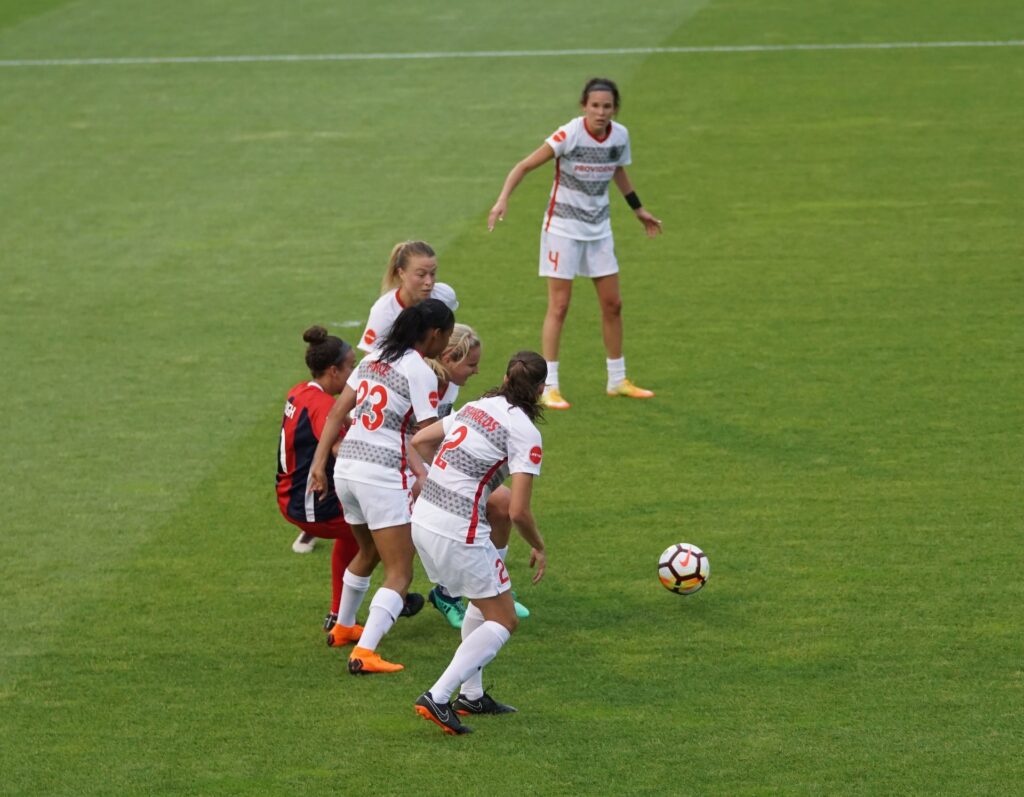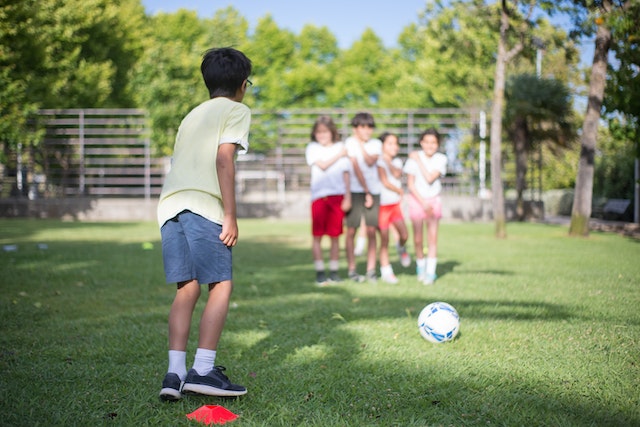Each sport throws up unique terms and quirks that become ubiquitous within the sport, but have you ever given consideration to where they come from? Or why they’re called what they’re called?
Here you’ll find a guide to defensive walls in soccer, including the rules when building a wall, the best ways to utilize a wall, and how effective they are in the game.
What is a defensive wall in soccer?
A defensive wall is the line of players you will see facing the free-kick taker at least 10 yards away from the ball.
The idea of the wall is to block free kicks, which are either heading toward going or into a dangerous area where another player might connect with the free kick.
A defensive wall can be made up of however many players that the defending side has on the field, but they usually contain between 3-5 for free kicks within goal-scoring range or 1-3 for free kicks, which are likely to be crossed into the box.
You might occasionally see one player 10 yards away from a corner taker or stopping a quick free kick finding an open man, but one player isn’t enough to be considered a wall.
What are the rules associated with building a wall?

Any wall formed needs to be 10-yards away from the spot where the free kick is to be taken.
The only instance this might not be the case is when an indirect free kick is awarded in the penalty box (because of a goalkeeper picking up a pass from their teammate, for instance) so players can be on the goal-line between the posts.
Prior to 2019, players of the attacking side could infiltrate the defensive wall to wreak havoc among the defensive ranks, aiming to break up the wall and create gaps for the ball to travel through.
However, the laws now dictate that if a defensive wall contains at least three players, then the opposing team must stay a yard or more away from the wall until the free kick has been taken.
Although not always used, an attacking wall, either in front or behind the defensive wall, is built to further restrict the goalkeeper’s view.
When should you build a wall and why?
Defensive walls are usually built when the opponent has a set play in a threatening position.
If the free kick is awarded to the opposition in their own half of the pitch, there’s no need to set up a wall because they’re incredibly unlikely to shoot from that position, and there isn’t a lot a wall could do that far from your goal anyway.
When the free kick is awarded in your defensive zone, it’s a good idea to start setting up your wall immediately. Rather than arguing with the referee over the decision, get your teammates sorted so that you are prepared in case the attacking team takes a quick set-piece.
Teams form walls because they can block the opponent’s shot on goal or cross into the box, or at least obstruct the opponent’s view of the goal or target area.
Why does a player lie behind the wall at free kicks?
You might see a player lying on the ground behind the wall because clever free-kick takers could look to sneak the ball underneath the wall when they jump.
The reason walls jump is simply that it makes it harder for free-kick takers, most of whom aim to get the ball over the wall before it drops under the crossbar.
Modern managers have sought to prevent this from happening by utilizing a player not in the wall to act as the ‘draught excluder.’
Not everybody is a fan of this, though; there are some that feel the low number of free kicks that actually result in goals (hardly any of these in Premier League history, for example, being shot under the wall) makes employing a draught excluder merely posturing when the player could be of better use elsewhere.
Yet there is no denying that, when called upon, the person who lies behind the defensive wall serves a useful purpose.
How to protect yourself in a defensive wall in soccer?
The most sensible thing to do when positioned in the wall is to protect below the belt.
It’s a contentious issue among soccer fans regarding using a hand to protect your face in free kicks. If you lift your arm upwards and the ball strikes it, you risk giving away a penalty – the stats for this are supposedly higher than you might think.
However, the laws of the game state that “intent” is a factor in any handball decision. Unfortunately, referees can’t seem to agree these days on what constitutes a handball at the top level of soccer, leaving the rest of us further in the dark.
If the players are of a certain age, a lot of managers would probably ask them to potentially take the pain of the ball striking their head for the sake of their team.
When it looks like the ball is heading towards your face, keep your head down slightly so that the ball won’t strike you square in the face, nor will it hit the base of your head; both of these would hurt!Your forehead is the best and least painful area of your head to divert the ball away.
Does a defensive wall make a difference in soccer?
Yes, a defensive wall makes a huge difference in soccer. Imagine your goalkeeper is facing a free kick without a wall. It would be difficult to guess which side of the goal the taker would aim for.
Naturally, players aim to dip a shot over the wall because they know this is their best chance of scoring if they achieve this first stage of the free kick.
When the wall is present, it is usually built in front of the post closest to the ball’s position, where the free-kick is awarded. The wall’s purpose is to block the free kicks aimed toward the near post.
This means that the goalkeeper will likely be positioned towards the far post to cover the side of the goal not protected by the wall. If a free kick is aimed at the far post and therefore misses the wall entirely, it should be handled by the goalkeeper.
Three tips for building an effective defensive wall
- Get your angles right – this is often the job of the goalkeeper, but a member of the wall will need to face the keeper and help them by following their orders and nudging their teammates along.
- Consider involving your tallest players – the logic behind this is straightforward: the taller the players in the wall are, the harder it is for set-piece takers to elevate the ball over them and also keep it below the crossbar.
- Don’t turn away from the shot – while it might be tempting to turn away from the ball heading towards a wall; you will lose sight of where the ball ends up once it’s taken, thus leaving you unprepared for potential rebounds and scrabbles. Turning your body side on is likely to reduce your body mass facing the free kick taker, too, making it a bit easier for them.
Recap: Building a defensive wall in soccer
Defensive walls are an integral part of soccer and have been for generations. You’ll almost certainly see at least one built during every soccer match you watch.
How they’re formed and the reactions of these players once the free kick is taken varies by the team, but knowing the background behind this aspect of soccer can help your team restrict your opponent when they’re within sight of the goal from a dangerous position.


Hi there
In a defensive wall, are the defending players in the wall allowed to hook arms.
Kind regards
Celso
Hey Celso – thanks for your question! Yes, they are – there’s nothing in the laws of the game preventing this. However, with the new handball rule, you need to be careful with this as you don’t want to give away a penalty!